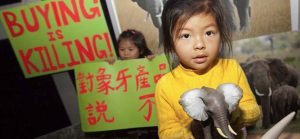
Friends of Elephants,
You will have heard of China’s astonishing vow to end the ivory trade within their borders. This, accompanied by yet another ivory crush in Beijing demonstrates their will to set about ending the ivory trade. It is the signal we have awaited for a long time. The Chinese concept of ecological civilisation is becoming reality for elephants. New data suggests that the price of ivory in China may have already begun stagnating in 2014 amid the first significant reduction in the number of licensed ivory factories and retail outlets (read more here).
Save the Elephants has always maintained that people around the world do not want to see an end to elephants. Rather than teach, educate or pressurise China or any nation, we seek to share our awareness of the facts of what is happening to elephants, believing that understanding will lead to real action to save elephants from poachers, traders and buyers.
From declaration of intent to effective action is a long road. China has shown vital leadership in using her power and influence towards ensuring a future for Africa’s elephants. However, as the government’s spokesman said, China cannot act alone. Taking the next step, in unity with the US, Europe and Africa, will require greater resolve from all parties.
Within the same week the euphoria of hearing the Chinese announcement came a grim reminder of how serious the ivory carnage is. From Tanzania came horrific confirmation of what we already feared. The official estimate is that 65,000 elephants have been killed in the last five years. In the words of the minister for Natural Resources & Tourism, The famed Ruaha National Park and Rungwa Game Reserve has become a “slaughterhouse for elephants”. Three quarters of these elephants are estimated to have been destroyed in just four years. If such a storm can have a silver lining, it is that at last the Tanzanian government is facing the collapse of their elephant population head on. From this honesty it will be possible to find away out of the mess.
In the Selous Game Reserve, where I made the first aerial census in 1976 and counted over 110,000 elephants, the numbers had been reduced to around 13,000 by 2013. The Paul Allen Family Foundation’s Great Elephant Census has confirmed this crash and has identified other poaching hotspots across the elephant range. Niassa in Northern Mozambique has suffered a similar massacre.
The Great Elephant Census has also demonstrated that there is hope for elephants. In Botswana elephants still thrive, thanks in part to the low human population density, the thriving economy, the prevalence of law and order, low corruption and above all political leadership to deploy the army to take on the poachers.
Increasing sophistication of technology is helping too. DNA analysis from our collaborator Sam Wasser in Seattle has identified the current hotspots and how the poachers have shifted their depredations around Africa from one country or region to another seeking the least protected populations and the easiest corruptible avenues for exporting their booty.
Concerned individuals, scientists, conservation organisations, businesses, actors and activists, politicians and governments themselves need to join arms to take united international action to stop the killing and trafficking, and we all know that all efforts would be futile without curbing the major driver of the problem – demand for ivory. In this light the Chinese initiative offers a bright ray of hope.
Many thanks for being part of the coalition to save elephants. Together, we can ensure a future for this magnificent species.
All best,
Iain

